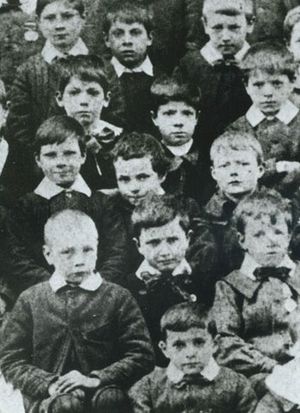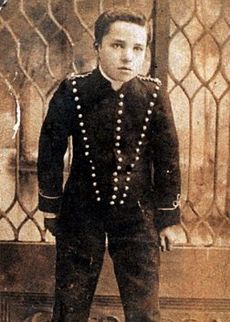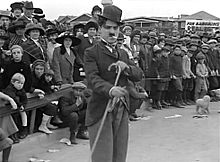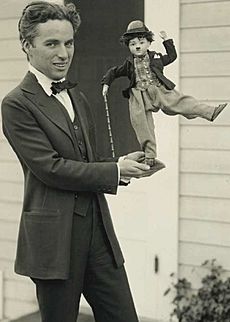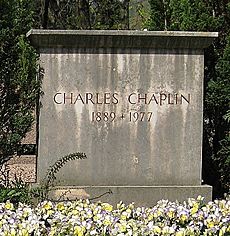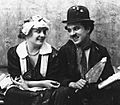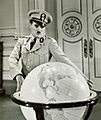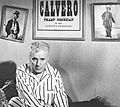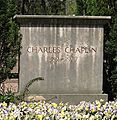Charlie Chaplin facts for kids
Quick facts for kids
Charlie Chaplin
|
|
|---|---|
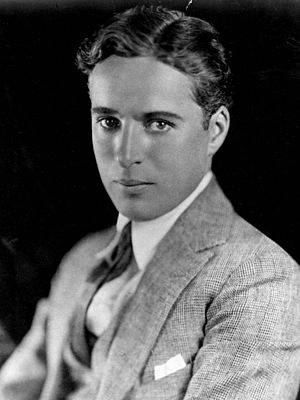
Chaplin in the early 1920s
|
|
| Born |
Charles Spencer Chaplin
April 16, 1889 London, England
|
| Died | December 25, 1977 (aged 88) Corsier-sur-Vevey, Switzerland
|
| Burial place | Cimetière de Corsier-sur-Vevey, Corsier-sur-Vevey, Switzerland |
| Occupation |
|
| Years active | 1899–1975 |
|
Works
|
Full list |
| Spouse(s) |
|
| Children | 11, including Charles, Sydney, Geraldine, Michael, Josephine, Victoria, Eugene and Christopher |
| Parent(s) | Charles Chaplin Sr. Hannah Hill |
| Relatives | Chaplin family |
| Signature | |
Sir Charles Spencer Chaplin (April 16, 1889 – December 25, 1977) was a famous English actor, filmmaker, and composer. He became very well known during the time of silent movies. His most famous character was the Tramp, a lovable and clumsy character with a small mustache, baggy pants, and a cane. Many people think he was one of the most important people in movie history. He worked for over 75 years, starting when he was a child in the Victorian Era and continuing until just before he died in 1977.
Contents
Early Life
Charles Spencer Chaplin Jr. was born on April 16, 1889, in London, England. His parents, Hannah Chaplin and Charles Chaplin Sr., were both entertainers in music halls.
Charlie's childhood in London was difficult. His father wasn't around much, and his mother struggled to make enough money. Charlie and his half-brother Sydney often lived in homes for children. They sometimes didn't have enough food and were treated strictly. His mother wanted him to finish school, but he left when he was thirteen. When he was fourteen, his mother became very ill and had to go to a special hospital. She never fully recovered and passed away in 1928.
Career Highlights
Chaplin started performing at a young age. He toured music halls and later worked as a stage actor and comedian. His first important job was with a group called The Eight Lancashire Lads. In 1900, his brother Sydney helped him get a role as a funny cat in a play called Cinderella.
Later, he played a clown in Fred Karno's comedy group, known as the "Fun Factory." At 19, he joined the Fred Karno company, which took him to the United States. People in the movie business noticed him. In 1914, he started working for Keystone Studios. He soon created his famous character, the Tramp. This character was lovable, a bit foolish, and mischievous, and audiences quickly fell in love with him.
By 1915, Charlie Chaplin was incredibly famous. Shops sold Chaplin toys and merchandise. He appeared in cartoons and comic strips, and many songs were written about him. As his fame grew around the world, he became the first international movie star.
Chaplin knew how popular he was. He asked for a large signing bonus from his next studio. He received several offers, and the best one was from Mutual Film Corporation. They offered him $10,000 per week.
In 1919, Chaplin helped start a movie company called United Artists. This company gave him complete control over his films. Chaplin wrote, directed, produced, edited, starred in, and even composed the music for most of his movies. He was a perfectionist, meaning he wanted everything to be perfect. His financial freedom allowed him to spend years making each film just right. His first full-length movie was The Kid (1921).
His first movie with sound was The Great Dictator (1940). This film made fun of Adolf Hitler. Later, some people thought Chaplin supported communism, so the FBI started looking into him. Because of this, Chaplin moved to Switzerland. He stopped using the Tramp character in his later films.
Personal Life
Charlie Chaplin was married four times. All of his wives were actresses: Mildred Harris, Lita Grey, Paulette Goddard, and Oona O'Neill. He had a total of eleven children with three of his wives. Many of Chaplin's children later became involved in the entertainment industry themselves. Some even appeared in movies with their famous father.
Later Years
Starting in the late 1960s, Chaplin had several small strokes. Even though he still had ideas for new movies, by the mid-1970s, he was very weak. He had more strokes, which made it hard for him to talk. He also needed to use a wheelchair. He kept working as much as he could.
In 1975, Queen Elizabeth II gave Chaplin a special honor, making him a knight. He was too weak to kneel, so he received the honor while sitting in his wheelchair.
Death and Legacy
Charlie Chaplin passed away at home on Christmas Day, 1977, after having a stroke in his sleep. He was 88 years old. His funeral was a small, private ceremony, just as he wanted.
Chaplin's children now manage his legacy through the Chaplin office in Paris. His main collection of old documents and items is kept in the archives of Montreux, Switzerland.
The British Film Institute has also created the Charles Chaplin Research Foundation. The first international Charles Chaplin Conference was held in London in July 2005. Many items from Chaplin's films are kept by the Academy Film Archive.
Commemorations
- In London, there is a statue of Chaplin as the Tramp in Leicester Square. It was made by John Doubleday and revealed in 1981.
- A road in central London is named "Charlie Chaplin Walk."
- There are nine special blue plaques in London, Hampshire, and Yorkshire that remember Chaplin.
- In Canning Town, East London, the Gandhi Chaplin Memorial Garden opened in 2015. It remembers when Chaplin met Mahatma Gandhi at a local house in 1931.
- The Swiss town of Vevey named a park after him in 1980 and put up a statue there in 1982.
- In 2011, two large paintings of Chaplin were put on two 14-story buildings in Vevey.
- Chaplin has also been honored by the Irish town of Waterville. He spent several summers there with his family in the 1960s.
- A small planet, 3623 Chaplin, was named after him in 1981.
- In the 1980s, the image of the Tramp was used by IBM to advertise their personal computers.
- Chaplin's 100th birthday in 1989 was celebrated with many events around the world.
- On April 15, 2011, Google celebrated him with a special video on their homepage.
- Chaplin's last home in Switzerland, Manoir de Ban, is now a museum called "Chaplin's World."
Awards and Recognition
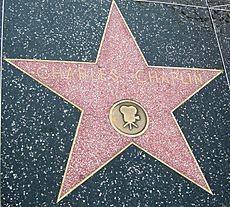
Chaplin received many awards and honors, especially later in his life. In 1975, he was made a Knight Commander of the Order of the British Empire (KBE) by the Queen. He also received honorary degrees from the University of Oxford and the University of Durham in 1962.
In 1965, he won the Erasmus Prize along with Ingmar Bergman. In 1971, the French government made him a Commander of the National Order of the Legion of Honour.
From the film industry, Chaplin received a special Golden Lion at the Venice Film Festival in 1972. He also received a Lifetime Achievement Award from the Film Society of Lincoln Center the same year. This award is now called The Chaplin Award. Chaplin was given a star on the Hollywood Walk of Fame in 1972.
Chaplin received three Academy Awards. He was nominated for Best Actor, Best Original Screenplay, and Best Picture for The Great Dictator. He also received another Best Original Screenplay nomination for Monsieur Verdoux. In 1976, Chaplin was made a Fellow of the British Academy of Film and Television Arts (BAFTA).
Famous Quotes
- "Life can be wonderful if you're not afraid of it. All it needs is courage, imagination ... and a little dough."
- "Imagination means nothing without doing."
- "You’ll never find rainbows if you’re looking down."
- "Let us strive for the impossible. The great achievements throughout history have been the conquest of what seemed the impossible."
Interesting Facts
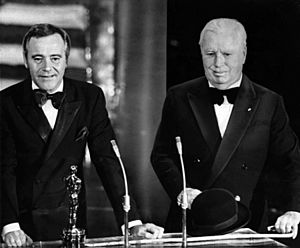
- Chaplin had two half-brothers from his mother's side: Sydney John Hill and George Wheeler Dryden.
- He first started acting at age five. He performed in a music hall in 1894, filling in for his mother.
- Chaplin said his mother was the biggest influence on his acting. When Charlie was a child, he was sick in bed for many weeks. At night, his mother would sit at the window and act out what was happening outside.
- Chaplin loved music as a child and taught himself to play the piano, violin, and cello.
- At age 26, Chaplin became one of the highest-paid people in the world. He had a contract for $670,000 a year.
- On July 6, 1925, Chaplin became the first movie star to be featured on a Time magazine cover.
- Chaplin started adding music to his silent films, composing the scores himself. He did this for City Lights (1931) and all his later films.
- At the first Academy Awards, Chaplin received a special trophy for his amazing talent in acting, writing, directing, and producing The Circus.
- In 1972, at the Academy Awards show, he received a 12-minute standing ovation. This was the longest in the Academy's history.
- There's a story that Chaplin once entered a Charlie Chaplin look-alike contest and didn't win!
- The British Film Institute calls Chaplin "a towering figure in world culture." Time magazine included him in their list of the "100 Most Important People of the 20th Century."
- In 1999, the American Film Institute ranked Chaplin as the 10th greatest male star of Classic Hollywood Cinema.
- Chaplin's most famous character is the Tramp. In 2006, a bowler hat and a bamboo cane from the Tramp's costume were sold for $140,000 at an auction.
- Chaplin helped inspire the cartoon characters Felix the Cat and Mickey Mouse.
Movies
|
|
Images for kids
-
Chaplin and Edna Purviance, his regular leading lady, in Work (1915)
-
The Kid (1921), with Jackie Coogan, was Chaplin's first movie longer than an hour.
-
The Tramp eats his boot in The Gold Rush (1925).
-
Lita Grey, one of Chaplin's wives.
-
Chaplin made fun of Adolf Hitler in The Great Dictator (1940).
-
A 1922 image of Charlie Chaplin Studios, where many of Chaplin's films were made.
-
Chaplin as the Tramp, a famous movie character, in 1915.
-
A Chaplin impersonator and his audience in San Sebastián, Spain, in 1919.
-
Chaplin memorial plaque in St Paul's, Covent Garden, London.
See also
 In Spanish: Charles Chaplin para niños
In Spanish: Charles Chaplin para niños


